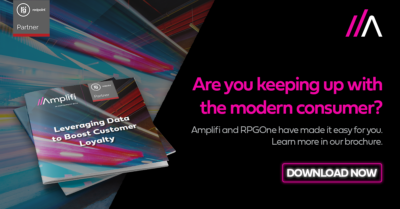Over the last two years, the digital commerce wave has crashed over retail — and Grocery is arguably one of the most impacted segments.
The way customers shop for groceries has shifted from in-store-only buying to online shopping and curbside pickup. As noted in our recent blog about the new consumer persona, 49% of shoppers either started or increased buying groceries online during the pandemic. And most shoppers have fully adapted to this new mode of grocery shopping. The changes are here to stay.
As we continue our series on customer data and loyalty, we’ll dive deeper into another segment where retailers are taking a fresh approach — the Grocery industry.
Moving From Shelves to Screens
Grocers have always relied on in-store experiences to make sales. However, as digital commerce gains steam, grocers must adapt to the new research-savvy customer.
Online shopping is more prevalent than ever, with online grocery sales projected to reach $187 billion in the U.S. by 2024. Grocers must place just as much (if not more) emphasis on their digital strategy as on their in-store interactions.
However, tapping into the online market requires grocers to adopt a more data-focused approach, with customer data as a key component.
Four Steps to Better Loyalty for Grocers
Grocers that offer multiple channels to their shoppers can expect higher revenue. Studies show that grocery customers spend as much as 20% more when using an omnichannel approach (online and in-person) than when shopping in-store alone. Those omnichannel customers are also more likely to be repeat buyers.
Providing multiple channels and personalizing grocery buying experiences are key to fostering increases in loyalty. But with inadequate data management, you can’t consistently give grocery customers (or shoppers in any market) the experiences they crave. In fact, only 28% of customers would rate retailers’ omnichannel consistency as “excellent,”.
If you’re a grocer looking to leverage customer data for consistently personalized and engaging experiences, here are four points to consider.
1: More Access to First Party Customer Data Than Ever
To build loyalty and personalize experiences, you need to know your grocery customer. Fortunately, with apps and loyalty points programs, grocers have access to more customer data than ever before.
Buy Online, Pick Up In Store (BOPIS) is another great source of valuable data. Grocery customers want more convenient experiences – like populating shopping lists based on recent orders or based on specific recipes— to make grocery shopping faster than ever. They’ll happily participate and provide data in exchange for value.
Be aware that the type of data available is also changing. Browsers are phasing out third-party cookies, so acquiring first-party data — information collected directly from the customer through web and app analytics and user behaviors — is now even more essential.
2: A Golden Record For Each Grocery Customer
Once you have your customers’ data, what do you do with it? If it goes to an ungoverned data repository, you’ll get low-quality results.
To create personalized customer experiences and achieve loyalty with grocery shoppers, you need to build a Golden Record for each customer. A customer data platform (CDP), your customer data is currated from all your channels and disparate sources into a Single Customer View. You can leverage this complete, accurate view of each customer to drive the individualized interactions that earn loyalty.
3: Mix in Multiple Domains of Grocery Data
To take personalization to the next level, you can combine your already valuable customer data with other data domains.
As an example, consider a customer who primarily buys organic products. Looks like you have a very health-conscious buyer! You know this based on past purchases shown within that customer’s Golden Record. You also know, based on data from your supply chain and the location of your customer, that organic peaches are coming into season. Armed with enticing photos (thanks to digital asset management (DAM) and data from your Product domain, you can anticipate their preference for organic seasonal peaches, and serve up personalized offers accordingly.
The beauty of a multi-domain approach is that the domains work together to offer your customers products that you know will interest them. And when customers feel like you understand them, they’re more likely to buy (and buy more often).
4: Better Data = More Loyalty in the Grocery Space
Buyers typically treat grocery shopping as more of a task than a treat. But that doesn’t mean they’ll settle for poor, impersonal experiences.
According to a Redpoint Global/Harris Poll, 82% of consumers are loyal to brands that demonstrate a thorough understanding of them as a unique customer. When grocery customers know you “get them” then loyalty follows.
Automated machine learning helps grocers draw the best insights from the Golden Record in real-time through decisioning and working out what the recommendations should be and delivering an experience personalized customer to that specific grocer. Also, a real-time decision engine calculates the next-best action for each grocery customer. So, shoppers get the best offer at the exact time they want it thanks to the experience delivery from the Intelligent Orchestration piece of rgOne.
Combining the Right Ingredients to Earn Long-Term Grocery Customers
Hyper-personalization is now crucial in the grocery industry, and combining quality data with a leading CDP is a must. Yet, putting all the ingredients together—from strategy, technology, processes, and beyond—can be a challenge.
That’s why Amplifi and Redpoint Global have partnered to deliver an end-to-end approach.
Amplifi’s data management consultants help grocery companies establish proven data strategies, then successfully implement the market-leading CDP solution, rgOne.
rgOne is built on the three pillars of customer data management, automated machine learning, and intelligent orchestration. These pillars enable grocers to deliver hyper-personalized experiences at scale.
To learn more about what’s possible with Amplifi and Redpoint, download our eGuide.



